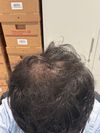community On the topic of HMI-115 and prolactin: has anyone tried adding Vitamin B6 (P-5-P) to their topical solutions?
The conversation discusses the potential benefits of adding Vitamin B6 (P-5-P) to topical hair loss treatments like RU58841, finasteride, or minoxidil. The user suggests that Vitamin B6 might enhance these treatments by naturally lowering scalp prolactin.




